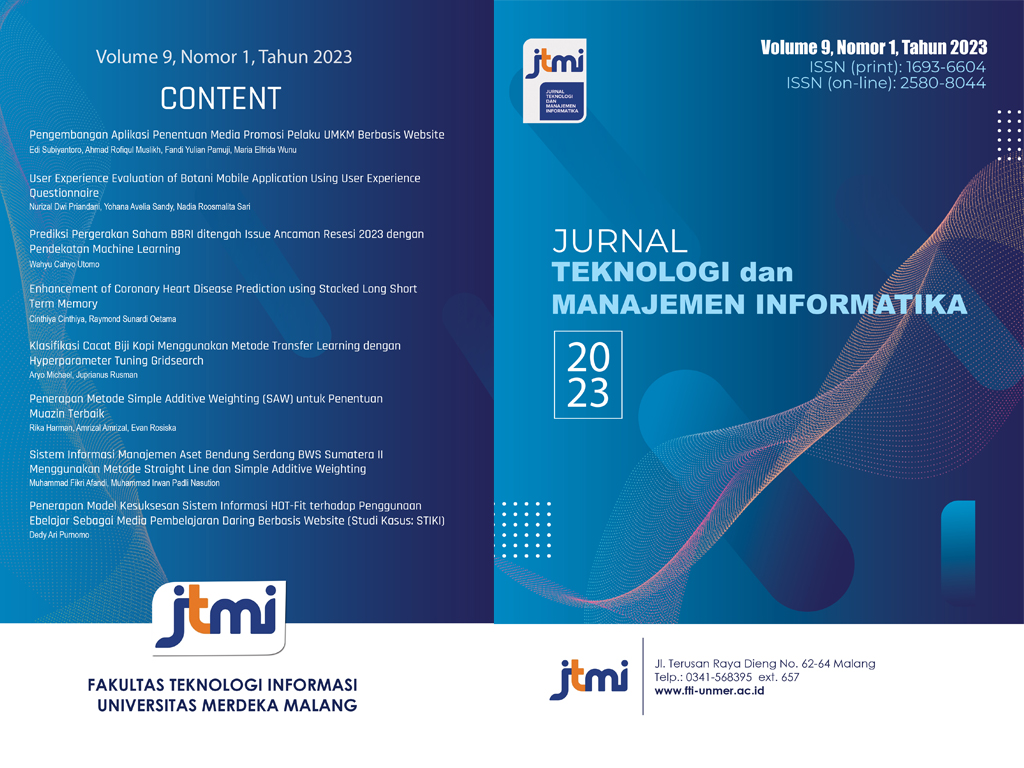Sistem Informasi Manajemen Aset Bendung Serdang BWS Sumatera II Menggunakan Metode Straight Line dan Simple Additive Weighting
DOI:
https://doi.org/10.26905/jtmi.v9i1.10107Keywords:
System Information, Asset Management, Straight Line, Decision Support System, Simple Additive WeightingAbstract
Serdang Dam is one of the water resource dams managed by the Regional Office of the Sumatra II River Basin, which is a technical implementing unit of the Ministry of Public Works and Public Housing located in North Sumatra Province. Asset management at Serdang Dam has been done manually through recording and bookkeeping, which are then inputted into a document file. This system has several shortcomings, including difficulties in tracing asset information in each activity and the lack of a basis for asset depreciation and acquisition calculations, resulting in suboptimal asset management processes. To overcome these issues, research will be conducted to facilitate the management of Serdang Dam assets by developing an asset management information system using the Straight Line and Simple Additive Weighting methods. The findings of this research will provide a solution to the existing problems by creating a system that can assist in managing Serdang Dam assets in all its activities.
Downloads
References
W. Mudiar, U. Hidayat, S. Informasi, and S. Informasi, Sistem Informasi Manajemen Asset Berbasis Web Pada Perbanas Institute, Inf. Manag. Educ. Prof., vol. 4, no. 1, p. E-ISSN: 2548-3331, 2019.
F. Fatma and J. Devitra, Analisis Dan Perancangan Sistem Informasi Manajemen Aset Berbasis Website Pada Biro Pengolahan Barang Milik Daerah SETDA Provinsi Jambi, J. Manaj. Sist. Inf., vol. 4, no. 1, pp. 28-37, 2019.
M. Daud, Evaluasi Dimensi Saluran Irigasi Daerah irigasi Sungai Serdang Kabupaten Deli Serdang (Studi Kasus), 2019, [Online]. Available: http://repository.uma.ac.id/handle/123456789/10988
N. P. D. Mahyoni, A. Setiawan, and S. M. Siregar, Pengaruh Aset dan Modal Kerja Terhadap Laba Perusahaan pada Industri Makanan Minuman, J. Pengemb. Wiraswasta, vol. 24, no. 2, p. 133, 2022, doi: 10.33370/jpw.v24i2.669.
A. Khoirul and N. Hidayatulloh, Sistem Informasi Manajemen Aset (SIMAS) Pada Dinas Kebudayaan Dan Pariwisata Provinsi Sumatera Selatan Mengunakan Framework Laravel, vol. 92, no. 5, p. 177, 2019.
R. Ristiana and Y. Jumaryadi, Sistem Pendukung Keputusan Pemilihan Paket Wedding Organizer Menggunakan Metode SAW (Simple Additive Weighting), J. Sisfokom (Sistem Inf. dan Komputer), vol. 10, no. 1, pp. 25-30, 2021, doi: 10.32736/sisfokom.v10i1.946.
A. Azura and W. Wildian, Rancang Bangun Sistem Absensi Mahasiswa Menggunakan Sensor RFID dengan Database MySQL XAMPP dan Interface Visual Basic, J. Fis. Unand, vol. 7, no. 2, pp. 186-193, 2018, doi: 10.25077/jfu.7.2.186-193.2018.
H. Hasanah and T. Widiartin, Sistem Informasi Manajemen Aset Untuk Monitoring Pemanfaatan Dan Pengadaan Aset Perusahaan Di Cv. Cahaya Utama Teknik, Melek IT Inf. Technol. J., vol. 7, no. 1, pp. 15-40, 2022, doi: 10.30742/melekitjournal.v7i1.182.
G. R. U. Sinaga and S. Samsudin, Implementasi Framework Laravel dalam Sistem Reservasi pada Restoran Cindelaras Kota Medan, J. Janitra Inform. dan Sist. Inf., vol. 1, no. 2, pp. 73-84, 2021, doi: 10.25008/janitra.v1i2.131.
N. Sulfiqih and R. Sanjaya, Perancangan Sistem Informasi Manajemen Aset Di Perusahaan PT. Telkom Akses Berbasis Web, eProsiding Tek. Inform., vol. 1, no. 1, pp. 237–242, 2021, [Online]. Available: http://eprosiding.ars.ac.id/index.php/pti/article/view/275
Y. Trimarsiah and M. Arafat, Analisis dan Perancangan Website Sebagai Sarana, J. Ilm. MATRIK, vol. Vol. 19 No, pp. 1–10, 2017.
S. D. Putri Yanova and M. I. Padli Nasution, Augmented Reality for Visiting Guide To the Library Room, J. Tek. Inform., vol. 3, no. 5, pp. 1431-1437, 2022, doi: 10.20884/1.jutif.2022.3.5.608.
A. Profita, A. N. Ifan, and A. E. Burhandenny, Penerapan Metode Rapid Application Development (RAD) untuk Digitalisasi UKM Industri Busana Muslim, vol. 6, no. 2, pp. 171-179, 2022.
N. Aini, S. A. Wicaksono, and I. Arwani, Pembangunan Sistem Informasi Perpustakaan Berbasis Web menggunakan Metode Rapid Application Development (RAD) (Studi pada: SMK Negeri 11 Malang), J. Pengemb. Teknol. Inf. dan Ilmu Komput., vol. 3, no. 9, pp. 8647-8655, 2019, [Online]. Available: http://j-ptiik.ub.ac.id
Y. D. Wijaya, Penerapan Metode Rapid Application Development (Rad) Dalam Pengembangan Sistem Informasi Data Toko, J. SITECH Sist. Inf. dan Teknol., vol. 3, no. 2, pp. 95-102, 2021, doi: 10.24176/sitech.v3i2.5141.
O. Marpaung, S. Tinggi Ilmu Ekonomi Jayakarta Jakarta, and I. Abstrak, the Application of the Depreciation Method of Fixed Assets and the Influence on the Profit of the Company Pt. Sumber Agri Sehat, J. Manajemen, Akunt. dan Ekon., vol. 1, no. 1, pp. 41-54, 2022, [Online]. Available: https://jurnal.erapublikasi.id/index.php/JMAE/index
S. Suendri, A. M. Harahap, A. B. Nasution, and S. Kartika, Analisis Sistem Pendukung Keputusan Penentuan Lulusan Terbaik Menggunakan Lima Algoritma Pada Program Studi Sistem Informasi UIN Sumatera Utara Medan, Al-Ulum J. Sains Dan Teknol., vol. 7, no. 1, pp. 38-43, 2022, doi: 10.31602/ajst.v7i1.5839.
F. F. Rochman, I. K. Raharjana, and T. Taufik, Implementation of QR Code and Digital Signature to Determine the Validity of KRS and KHS Documents, Sci. J. Informatics, vol. 4, no. 1, pp. 8-19, 2017, doi: 10.15294/sji.v4i1.7198.
L. Setiyani, Pengujian Sistem Informasi Inventory Pada Perusahaan Distributor Farmasi Menggunakan Metode Black Box Testing, Techno Xplore J. Ilmu Komput. dan Teknol. Inf., vol. 4, no. 1, pp. 1-9, 2019, doi: 10.36805/technoxplore.v4i1.539.
Downloads
Additional Files
Published
Issue
Section
License
Copyright (c) 2023 Jurnal Teknologi dan Manajemen Informatika

This work is licensed under a Creative Commons Attribution-ShareAlike 4.0 International License.
Authors who publish with this journal agree to the following terms:
(1)Â Copyright of the published articles will be transferred to the journal as the publisher of the manuscripts. Therefore, the author confirms that the copyright has been managed by the journal.
(2) Publisher of JTMI: Jurnal Teknologi dan Manajemen Informatika is University of Merdeka Malang.
(3) The copyright follows Creative Commons Attribution–ShareAlike License (CC BY SA): This license allows to Share — copy and redistribute the material in any medium or format, Adapt — remix, transform, and build upon the material, for any purpose, even commercially.




